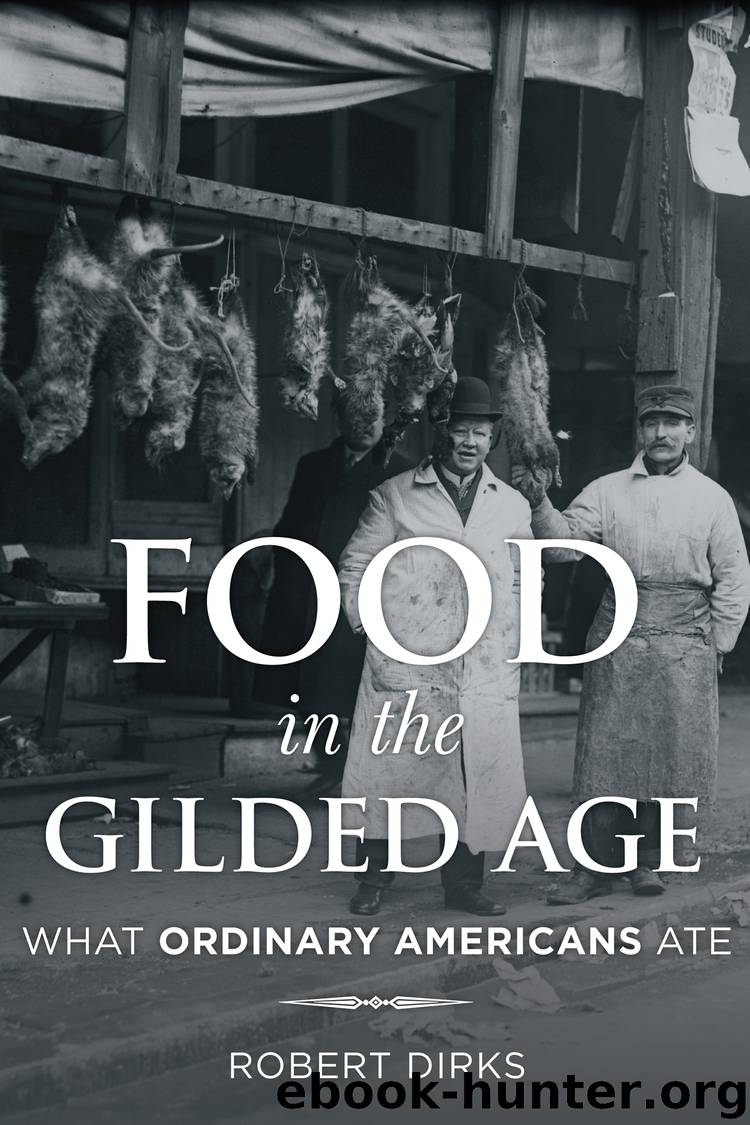Food in the Gilded Age by Robert Dirks

Author:Robert Dirks [Dirks, Robert]
Language: eng
Format: epub
Publisher: Rowman & Littlefield Publishers
Published: 2016-04-19T16:00:00+00:00
5
Immigrants’ Diets
Donna Gabaccia views the period from the late nineteenth through the early twentieth centuries as a uniquely conservative time in American culinary history.1 During the colonial era, people had been open to experimentation and change, but by the turn of the twentieth century most Americans were either unwilling or unable to try new foods. The unwilling identified strongly with their communities and cherished their accustomed food habits. The unable were prevented by their poverty from changing the way they ate. Together custom and privation collaborated to define seven major variations on the meat-rich, white-floured, heavily sweetened standard American diet. Gabaccia identifies the variants as northern European, southern European, Asian, Mexican American, and native southern (or African American).2 Previous chapters dealt with examples of mainstream American, the American South, and Mexican American diets. This chapter addresses food consumption among immigrants from Europe. Their dietaries attest to stark differences in nutrition among various nationalities. In addition, the dietaries indicate changes in diet as fortunes improved and lives became increasingly Americanized. This gives one pause and reason to think carefully about characterizing this period as conservative.
European Immigrants
Dietaries undertaken in Gilded Age America documented the eating habits of immigrants representing thirteen distinct European nationalities.3 Of these, German American groups received the most attention.4 This chapter examines eating and drinking among these and several other sets of European immigrants, including those from Bohemia, Great Britain, Ireland, Italy, and Russia’s Jewish communities.5
The eating habits of European Americans generally had much in common. Indeed, the typical diets of most of them shared a constellation of twenty-two core foodstuffs. Six of these, listed in table 5.1 as “Primary Core in All,” were universal among all of the ethnicities covered in this chapter. Eight counted as primary core foods among most European Americans. Another eight qualified as at least secondary core foods among most. The bottom row of the table, labeled “Included in Most,” represents those items that would qualify as peripheral to a typical European American diet. The items listed showed up in just two of the seven typical diets considered here. The specific, individual character of each of the diets took shape mainly through the addition and subtraction of primary and secondary core foods.
Download
This site does not store any files on its server. We only index and link to content provided by other sites. Please contact the content providers to delete copyright contents if any and email us, we'll remove relevant links or contents immediately.
| Culinary Biographies | Essays |
| Food Industry | History |
| Reference |
A Court of Wings and Ruin by Sarah J. Maas(7648)
The Death of the Heart by Elizabeth Bowen(3551)
The Sprouting Book by Ann Wigmore(3543)
Better Homes and Gardens New Cookbook by Better Homes & Gardens(3524)
BraveTart by Stella Parks(3394)
Salt, Fat, Acid, Heat: Mastering the Elements of Good Cooking by Nosrat Samin(3106)
Sauces by James Peterson(3049)
Kitchen confidential by Anthony Bourdain(3007)
The Bread Bible by Rose Levy Beranbaum(3003)
Classic by Mary Berry(2940)
Solo Food by Janneke Vreugdenhil(2927)
Ottolenghi - The Cookbook by Yotam Ottolenghi(2869)
Martha Stewart's Baking Handbook by Martha Stewart(2795)
Day by Elie Wiesel(2717)
Betty Crocker's Good and Easy Cook Book by Betty Crocker(2679)
The Plant Paradox by Dr. Steven R. Gundry M.D(2543)
My Pantry by Alice Waters(2542)
The Kitchen Counter Cooking School by Kathleen Flinn(2484)
Hot Sauce Nation by Denver Nicks(2450)
